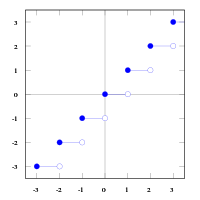
Back دالتان سقفية وأرضية Arabic Функция скобка Bulgarian Celá část Czech Тулли пай CV Abrundungsfunktion und Aufrundungsfunktion German Συναρτήσεις δαπέδου και οροφής Greek Planka kaj plafona funkcioj Esperanto Funciones de parte entera Spanish Zoru-funtzio eta sabai-funtzio Basque توابع جزء صحیح و سقف Persian
In mathematics, the floor function (or greatest integer function) is the function that takes as input a real number x, and gives as output the greatest integer less than or equal to x, denoted ⌊x⌋ or floor(x). Similarly, the ceiling function maps x to the smallest integer greater than or equal to x, denoted ⌈x⌉ or ceil(x).[1]
For example, for floor: ⌊2.4⌋ = 2, ⌊−2.4⌋ = −3, and for ceiling: ⌈2.4⌉ = 3, and ⌈−2.4⌉ = −2.
Historically, the floor of x has been–and still is–called the integral part, integer part, or entier of x, often denoted [x] (as well as a variety of other notations).[2] However, the same term, integer part, is also used for truncation towards zero, which differs from the floor function for negative numbers.
For n an integer, ⌊n⌋ = ⌈n⌉ = [n] = n.
Although floor(x+1) and ceil(x) produce graphs that appear exactly alike, they are not the same when the value of x is an exact integer. For example, when x=2.0001; ⌊2.0001+1⌋ = ⌈2.0001⌉ = 3. However, if x=2, then ⌊2+1⌋ = 3, while ⌈2⌉ = 2.
| x | Floor ⌊x⌋ | Ceiling ⌈x⌉ | Fractional part {x} |
|---|---|---|---|
| 2 | 2 | 2 | 0 |
| 2.0001 | 2 | 3 | 0.0001 |
| 2.4 | 2 | 3 | 0.4 |
| 2.9 | 2 | 3 | 0.9 |
| 2.999 | 2 | 3 | 0.999 |
| −2.7 | −3 | −2 | 0.3 |
| −2 | −2 | −2 | 0 |
- ^ Graham, Knuth, & Patashnik, Ch. 3.1
- ^
1) Luke Heaton, A Brief History of Mathematical Thought, 2015, ISBN 1472117158 (n.p.)
2) Albert A. Blank et al., Calculus: Differential Calculus, 1968, p. 259
3) John W. Warris, Horst Stocker, Handbook of mathematics and computational science, 1998, ISBN 0387947469, p. 151

